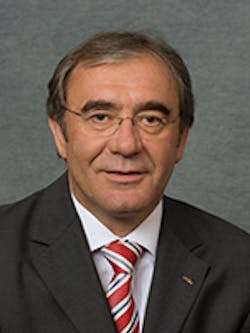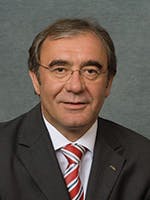The future for industrial laser materials processing
New laser technologies and emerging markets should support high single-digit growth rates in the long term
GÜNTHER BRAUN
When I was asked to contribute my thoughts on the future of global industrial laser material processing, I had to first channel my remarks to the most important facts and, of course, to the available space in the issue. The fact is that the laser industry has always been able to grow, on average, in the high single-digit percentage range, but what are the prerequisites or the foundation to achieve such growth rates? That is the important question.
Looking at the global market players, the industry was able to perform as it did because of a variety of specific reasons. Each player in the industrial laser space covers their own market niches and has special product lines that others might like to possess, but were not able to offer because of technological or commercial reasons.
So, what are the "keys"? A prime argument for laser companies to grow is diversification of laser technology! Looking back at the early days, the main development target was to increase laser output power and this counted for all technologies: CO2, solid-state, diode, and—even then—fiber laser technology. However, output power differentiation alone does not widen the possible/available markets and/or applications enough. Therefore, laser companies need to change the properties of lasers to address volume applications through variations in pulse length and/or wavelength. Many laser companies broadened their technology and product portfolio to enhance their role in the laser material processing markets. The question is, where and what are these markets?
Large market opportunities for lasers and even for short-pulse lasers exist in consumer electronics or semiconductor applications, including brittle material treatment like ceramics, sapphire, glass, polymers, etc. Consumer electronics giants need many different laser technologies for parts treatment because of miniaturization, cosmetic, or delicate material reasons.
The same holds true for the medical device industry, with all their implants and instruments. One of the major reasons for medical device applications is that laser technology fulfills the high quality requirements for perfect, hygienically clean surfaces that are dross- and material residues-free.
Also, green technologies like solar cell or battery production are perfect examples for industrial laser usage. There is no single technology able to cover the whole spectrum of industrial applications-only a mix of different laser technologies can do so and so far, even fiber laser technology is yet to prove to be the universal tool.
Another key is the Asian market. Comparing the sales split by region of publicly listed laser companies, you will find Asia in the 40–50% range of annual sales. Asia—especially China—is the market with tremendous growth rates in the past. Adjusted GDP rates in China in the range of 4–5% should still create great market opportunities for industrial lasers. Japan's market is locked on domestic laser players, but you can create a remarkable business when you are able to offer lasers that are not available from local laser companies. Singapore, Taiwan, and South Korea are mainly markets for consumer electronics or semiconductor applications. Of course, laser companies must cope with the cyclicality of these industries, but the need for lasers is large.
Chinese laser companies have evolved from more or less copy machines of Western laser technology to their own developed laser sources. These companies benefit from well-educated repatriates who brought and bring the laser and optics know-how from the Western world to the country. The key for success of Western laser companies is the recruiting of local industry experts, which are connected and embedded in the local environment. International laser companies that act locally will see the benefit through increased orders and sales, which means market penetration in Asia is a must for success.
Finally, which publicly listed laser company—Coherent, Han's Laser, IPG, Newport, or Rofin, or the private held company TRUMPF—is best positioned to take advantage of the large opportunities in laser materials processing?
As mentioned at the beginning, every laser company has its own history or DNA. Therefore, their opportunities are somewhat limited towards the existing laser technologies or product portfolios. And of course, market penetration as well as customer relationships are important additional aspects.
Looking at Coherent in microelectronics for industrial laser materials processing, this company is one of the important players in this market. One of their strengths, besides their strong CO2 laser portfolio, is in the field of annealing applications using excimer lasers-a 'killer' application serving the consumer electronics and semiconductors industries.
Han's Laser has more or less become a system manufacturer using lasers as a tool to be integrated in their systems. Han's is one of the dominant players in China, with good prospects to grow. However, their future role will depend on their ability to expand their business beyond China's borders.
IPG Photonics is without a doubt number one in fiber laser technology, and it has become the synonym for fiber lasers! They have a clear focus on industrial materials processing with great opportunities while broadening their fiber laser product portfolio towards different pulsing capabilities and wavelengths.
Newport, by addressing markets such as scientific research, life and health science, and industrial laser materials processing, plays a less important role. Therefore, their existent product portfolio is limited by available technologies to compete in the industrial laser space.
Rofin has a broad technology and product portfolio base, covering all essential applications in the industrial laser market. With its worldwide sales and service network, Rofin is a good partner for the industry. The company has great market opportunities with a special focus on fiber laser technology, especially in the high-power range.
TRUMPF's biggest laser customer is their in-house systems group. The company has a broad laser technology and product portfolio base, and its worldwide footprint makes them to one of the global key players in the market.
All of the above-mentioned companies are well positioned in their established markets, but from my point of view, I would assign the biggest growth opportunities to TRUMPF, IPG, and Rofin.
Editor's Note: It's a rarity when we are privileged to have a distinguished and highly regarded former member of the industrial laser community publically express his views on this technology. Günther Braun, until recently CEO of Rofin, is well positioned to comment on the future prospects for industrial laser material processing as the widely respected former leader of one of the world's largest suppliers of products to this vibrant industry. ILS thanks Günther for accepting the invitation to shares his thoughts with our global readers in this new year.—David A. Belforte

